Hello and welcome!
As I mentioned in my previous post, last Friday I celebrated a Mass at the shrine in San Giovanni Rotondo on the feast day of Padre Pio to mark the 20th anniversary of his canonization.
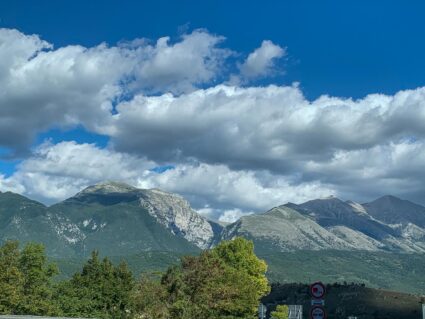
We made the 4-hour drive from Rome Thursday night and arrived in time for dinner.
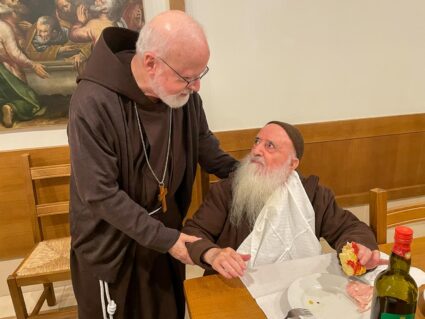
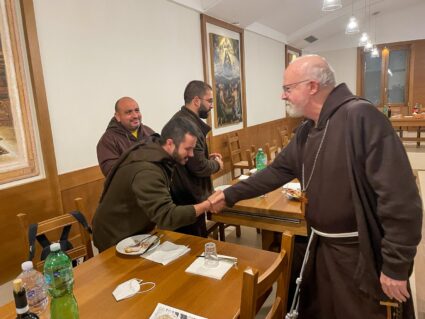
After dinner, they had a vigil for young people with a midnight Mass that was celebrated by the Vicar General of our order, Father José Angel from Puerto Rico.
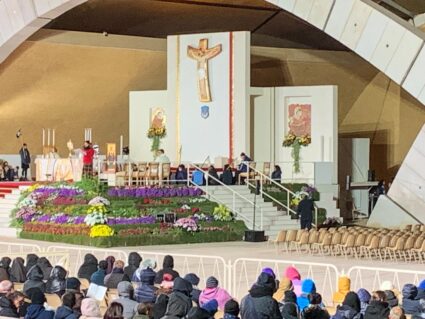
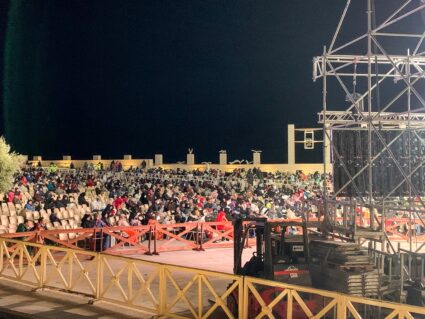
The next morning we had the Mass at the Basilica, where we were joined by several bishops including the Archbishop of Manfredonia-Vieste-San Giovanni Rotondo, Archbishop Franco Moscone.
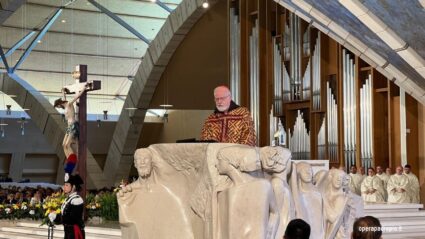
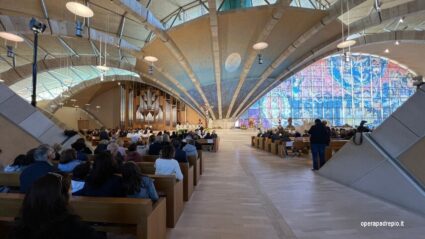
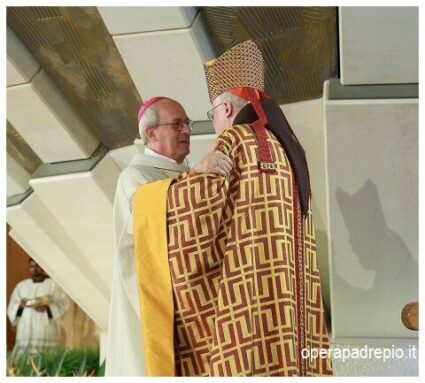
Greeting Archbishop Moscone
There were thousands of people there for both the vigil and the Mass and it’s always very moving to see the devotion of the people.
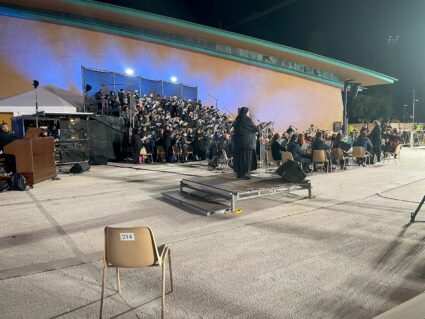
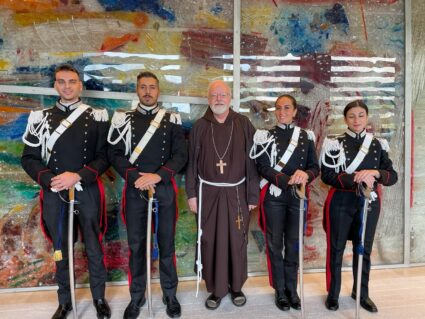
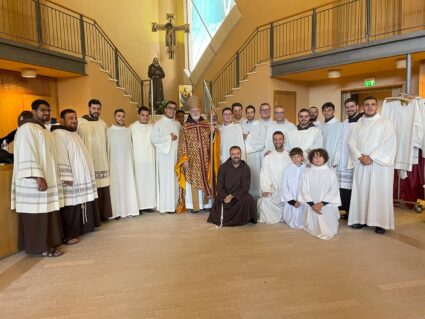
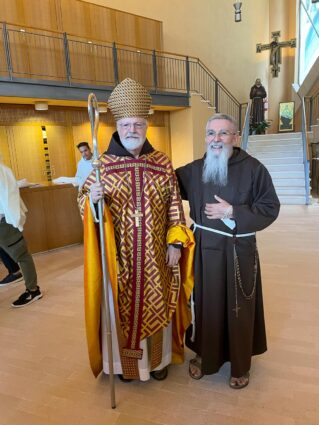
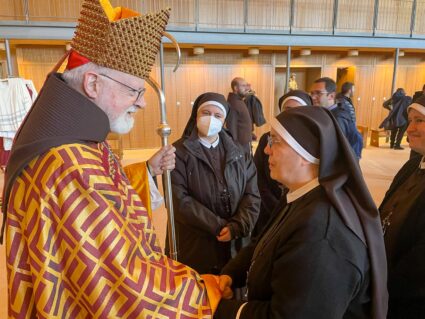
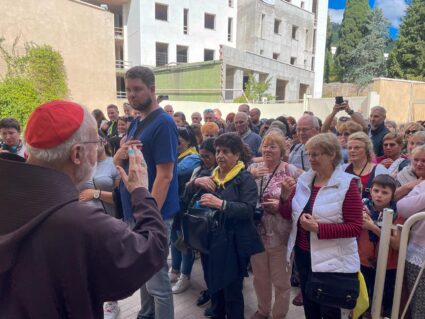
Of course, the Mass was celebrated in Italian, so while I’m sharing the video of my homily with you, I’d like to share the English text, as well.
Pope Francis has a great talent for coining expressions and calling our attention to profound spiritual realities in simple language. In his treatise on holiness, the Holy Father refers to “the Saints next door.” We all know people who come under that category. As a young priest, practically all of my parishioners were either undocumented workers or servants in the embassies and the homes of the well-to-do. They were often exploited and mistreated. I was rewarded for my advocacy on their behalf by being called: “El cura de las fregonas.” To this day, I consider that the most important title that anyone has bestowed upon me.
Among those undocumented laborers and servants, I came to know many who were truly very holy. They lived lives of great sacrifice to send money back to their starving relatives in their countries of origin. They lived lives of complete trust in God’s loving mercy, like the widow that Jesus points out, putting her last coins into the collection basket. They were truly the Anawim. As a young priest, I used to tell myself that I hoped that one day I would be as good and as holy as these people.
Today, we gather to celebrate the feast of one of our Capuchin brothers who is not a saint next-door. I am sure that Padre Pio would have been very happy to lead a hidden life and be one of those anonymous saints who go unnoticed and unheralded. In today’s Gospel, Jesus praises his heavenly Father for “having hidden these things from the wise and learned and having revealed them to the childlike.” Padre Pio was one of those little ones to whom God revealed himself. But in God’s plan, this poor, simple peasant was destined to become an instrument of revealing God’s loving presence and mercy to the whole world. God sometimes takes “the saint next-door” and puts the spotlight on that individual so that their life and witness can become a window, a portal, through which people are able to glimpse the presence of God, to discover God hidden in plain sight. People are quick to crowd around that window because of their hunger for God, their hunger for meaning, their hunger for forgiveness.
In 1947 the young, newly ordained Polish priest, Karol Wojtyla, sought out Padre Pio to receive the Sacrament of Reconciliation. Was Father Wojtyla motivated by curiosity, or by a desire to seek advice concerning a possible religious vocation to the Carmelite order, or simply by the longing to experience the holiness of a great mystic? We do not know all the historical facts about their encounter. Some claim that Padre Pio told this young priest he would one day be Pope. What we do know is that in 1962 John Paul II sent a letter in Latin asking Padre Pio to pray for a Polish colleague, Dr. Wanda Poltawski, who was afflicted with a serious form of cancer. We know that this woman was subsequently cured in a most marvelous fashion. I am sure that no one had to convince Pope John Paul II of the holiness, the heroic virtues, and the extraordinary impact of Padre Pio.
Twenty years ago, Pope St. John Paul II canonized this great saint whose life has touched so many millions of people throughout the world. Padre Pio was not an anonymous, hidden, saint next-door. Not just in Italy but almost anywhere in the world, you can find photos, images, and statues of Padre Pio, not just in churches but also in shops, restaurants and factories. How many people carry a picture of him in their wallet or pocketbook? Millions come here every year to visit his shrine, hundreds of thousands belong to the prayer groups he inspired, and at the end of his life, he was receiving 5,000 letters a day. But Padre Pio did not boast of his fame or notoriety. God chose him, a little one, to be a portal to the transcendent. God chooses the weak to confound the strong.
In today’s first lesson from the prophet Jeremiah, the word of God admonishes us saying: “Let not the wise boast of his wisdom, nor the strong boast of his strength, nor the rich boast of his riches.” The second reading takes up the same theme where St. Paul in Galatians says: “But may I never boast except in the Cross of our Lord Jesus Christ, through which the world has been crucified to me, and I to the world.” Padre Pio was a man who did not boast of his wisdom, nor his strength, nor his riches. Like Paul, his boast was in the Cross of our Lord Jesus Christ, and like the Poverello, Padre Pio became a living crucifix.
A few years ago, Pope Francis invited the “C9” Cardinals to accompany him on a pilgrimage to Assisi. It was a most memorable trip. We went by military helicopters from the Vatican Gardens to Assisi. The first stop in Assisi was the Instituto Serafico, which cares for severely handicapped children. Speaking with the children and their caregivers, Pope Francis reflected on how the Risen Christ ascended into heaven and took with him the wounds on his hands and feet and side. The Risen Christ is still the Crucified Christ. When he appears to his disciples, he identifies himself by showing them his wounds.
With Padre Pio, those wounds come back from heaven and make Christ closer, visible, present in our world.
In my parish of immigrants, I was privileged to have some “gitanos,” or in a more contemporary expression, Roma. Among them, I also discovered some saints next-door, people of deep faith and mysticism. There were many reports this year on how the processions of Holy Week in Spain were resumed after the pandemic. I saw a video on the Internet of someone singing a saeta. Saeta is a Spanish word for arrow and is the name of the songs that people sing from the balconies in Seville and the towns of southern Spain as the images of the Addolorata or the Nazareno pass by in procession.The words of the “saeta” were: “Who can lend me a ladder so that I can climb up the cross to pull out the nails from Jesus the Nazarene…. The Christ of the Gypsies who always have blood on their hands from pulling out the nails.” When we see Jesus’ pain with eyes of love, his pain becomes ours.
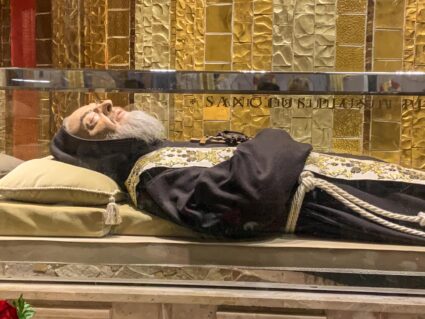
It is not hard to imagine Padre Pio calling out for a ladder to be able to climb the cross to embrace the crucified Lord and pull out the nails. Padre Pio’s hands were bloodied by those nails. Padre Pio could make St. Paul’s words his own: “I have been crucified with Christ, it is no longer I who live, but Christ who lives in me.” And “For I bear the marks of Jesus on my body.”
In today’s Gospel, Jesus invites us: “Take my yoke upon you and learn from me, for I am meek and humble of heart… For my yoke is easy, and my burden is light.” The yoke of Jesus is the cross. Padre Pio carried that yoke with love. The burden is to love God and to love one another. The burden is laid on us in love and is meant to be carried in love.
Many years ago, Hollywood produced a wonderful film about the life of Father Flanigan, who was famous for his ministry to orphans. One of the most memorable scenes is when Father Flanigan encounters the young boy carrying a smaller boy who has polio and is wearing leg braces. Seeing the boy struggle, Father Flanigan draws near to help, but the boy responds: “It’s all right, Father. He’s not heavy, he’s my brother.” The yoke is easy and the burden light when it is carried with love.
Padre Pio carried the burden of the stigmata for five decades. This and so many other physical sufferings were borne with love and patience. In a world where pain is seen as the greatest evil, Padre Pio shows us the power of the cross. He shows us that the greatest evil is not pain, but sin and selfishness. Pain can be a two-edged sword that turns us in on ourselves, leads to self-pity, anger or despair. When the cross is borne with love and in union with Jesus, it is life-giving and leads to resurrection.
Some of us were in St. Peter’s Basilica during the Year of Mercy when the Holy Father had the relics of Padre Pio and St. Leopold brought to Rome. Thousands of people came to pray before the relics. Of all the Holy Years I have experienced in my lifetime, the Year of Mercy declared by Pope Francis has been the most powerful. It is no surprise that the Holy Father chose Padre Pio as a saint who exemplifies the Church’s mission of mercy.
A couple of years ago in Rome I found a wonderful book by Cardinal Martini called “Come Gesu gestiva il suo tempo.” The Cardinal did a close study of the Gospels and distilled out a list of Jesus’ priorities. He gives the five priorities of Jesus. If someone had asked me what the first priority would be, I would have guessed that Jesus’ first priority was announcing the kingdom, preaching the Gospel. Actually, Cardinal Martini demonstrates that is Jesus’ second priority. His first priority was mercy, caring for the sick, casting out devils and feeding the hungry. That makes perfect sense because mercy is the context for preaching the Gospel. People will listen to our message only when they are convinced that we love them. Padre Pio embraced the same priority of Jesus. His was a mission of mercy, to those who were sick physically or spiritually and, in that context, he announced the Good News of the Gospel. The confessional and the Casa Sollievo della Sofferenza are just two of the ways Padre Pio manifested the loving mercy of God in the world convulsed by pain and suffering and sin.
The classic book of Russian spirituality of the 19th century is the “Racconti di un Pellegrino Russo.” The book was first found on Mount Athos in Greece. It is the story of a mendicant pilgrim who is practicing the Jesus prayer. His travels take him through southern and central Ukraine, Russia, and Siberia. His pilgrimage began when he heard the words from St. Paul’s first letter to the Thessalonians: “Pray without ceasing” that were proclaimed at the Divine Liturgy. The pilgrim repeats over and over again the Jesus prayer: “Lord Jesus Christ, have mercy on me.”
Padre Pio once described himself as “a poor friar who prays.” Padre Pio was certainly a man of prayer — of ceaseless prayer. Like Jesus, he was also a teacher of prayer and invited people to deepen their life of prayer and friendship with the Crucified Lord, the Blessed Mother and saints and angels. It is reported that the Father Guardian once asked him how many rosaries he said each day, and Padre Pio replied 34. That is more rosaries than most of us say in a month.
Like Jesus in the desert, on a mountaintop, in the garden of olives, Padre Pio was a man of constant prayer.
Like all great saints, Padre Pio’s life became a prayer. His days were a rosary lived, as Pope Benedict said, “in the continuous meditation and assimilation of Christ’s mysteries and in spiritual union with the Blessed Virgin Mary.” This explains the unique coexistence within him of supernatural gifts and human concreteness. And it all culminated in the celebration of Holy Mass in which Padre Pio was fully united with the Crucified and Risen Christ — from this profound life of prayer as an ever-living source of mercy and charity. The burning desire of Padre Pio was to bring healing, so that people might return to God, and might be able to experience God’s mercy, to rediscover the joy and beauty of discipleship, and the grace of friendship with Jesus, and of being part of Jesus’ family, the Church.
Padre Pio’s life of unceasing prayer transformed him and filled him with the light of Christ that helped guide people on the path to holiness. He truly became a window to the transcendent. As Ruffin says in his biography: “Padre Pio made God real.” In a world of unbelief, the presence of holiness brings light and peace into a world of darkness and chaos. The saints next door, and the saints that God magnifies with his graces are a gift to increase in us a nostalgia for homeland yet unseen, for which we were created.
Pope Francis said that the two paths to holiness are prayer and community. Padre Pio is an outstanding example of this in a society that has largely abandoned prayer and the Sabbath observance, but this holy man teaches us that prayer brings the power of the cross into our lives and allows us to enter into the mystery of the Eucharist. Many people have abandoned the Sunday Eucharist because they no longer know how to pray.
Today we stand in this holy place to ask Padre Pio to pray for us and teach us how to pray, to love and to heal. May he lend us that ladder that will allow us to climb the cross and lovingly pull out the nails from the hands of our brothers and sisters who are, as Mother Teresa used to say: “Christ in a distressing disguise.”
Today we stand before this great saint and say thank you for showing the world that God is real and that the only real success in life is holiness.
As part of the celebration, there was a blessing of three statues by the Canadian artist Timothy Schmalz, who is very well known for his sculptures “Homeless Jesus” and the “Angels Unawares.”
One statue we blessed appears to be a beggar when you look at it from one side but an angel when you look from the other. The others depict Padre Pio — one with him in conflict with the demons, and another one with the Blessed Virgin.
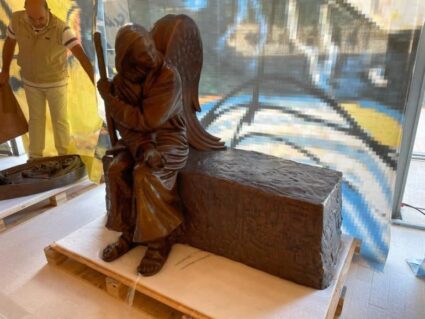
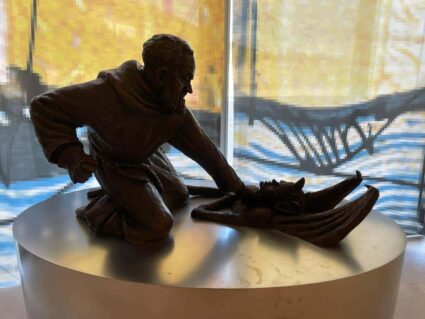
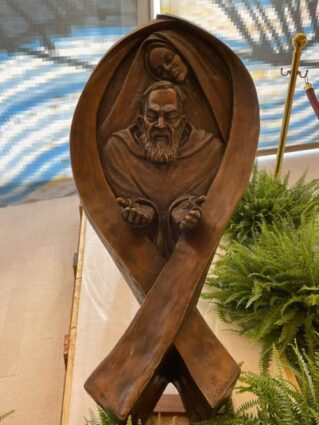
During my time at San Giovanni Rotondo, I was able to visit the shrine and the crypt.
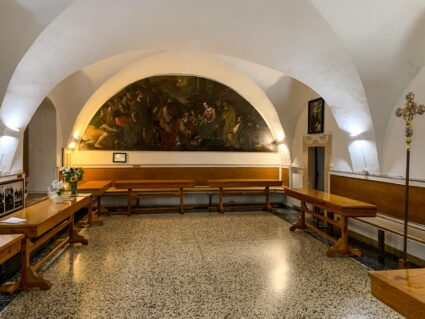
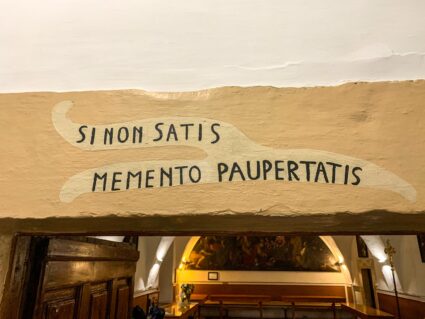
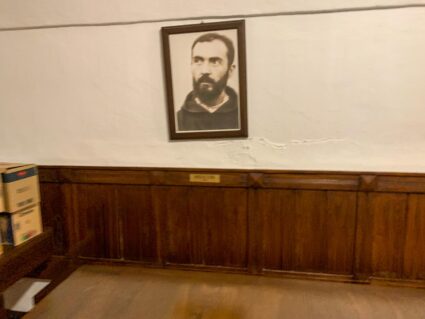
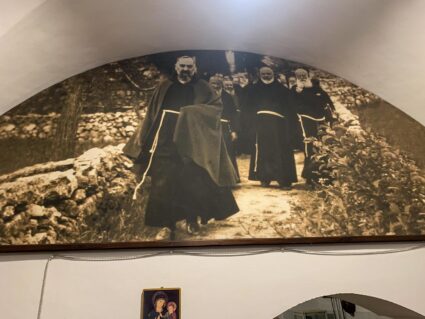
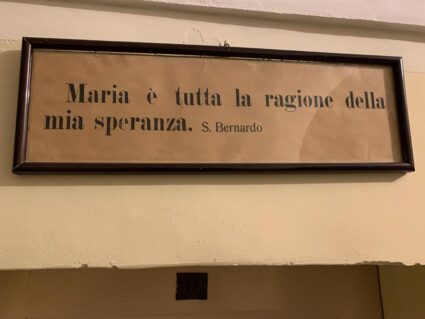
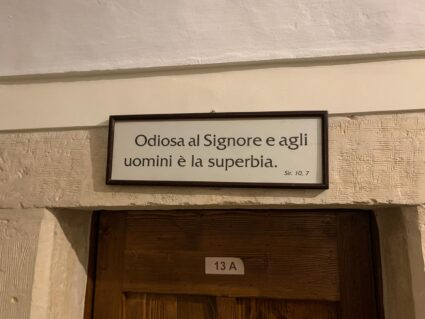
This picture is of the altar where, for many years, Padre Pio would celebrate Mass in private.
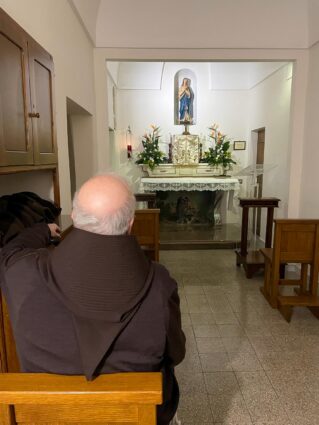
In the crypt where Padre Pio is buried, there is a long hallway with mosaics of scenes from the life of Padre Pio on one side and from the life of St. Francis of Assisi on the other.
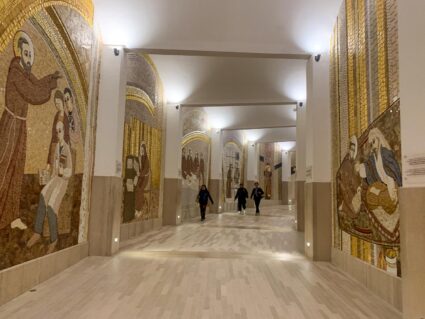
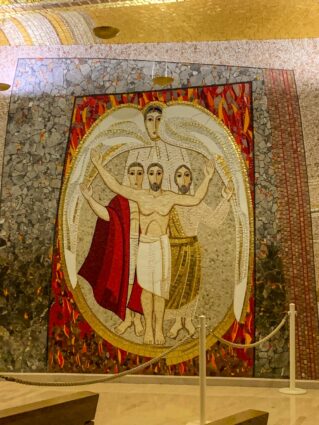
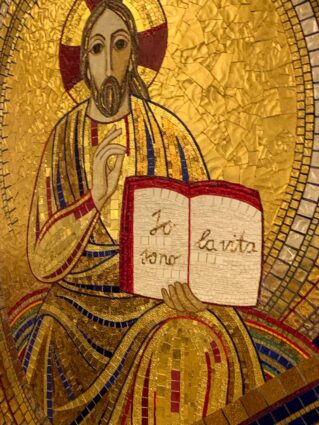
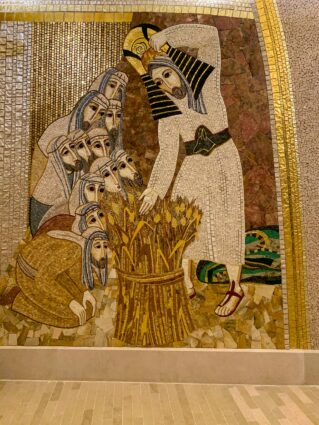
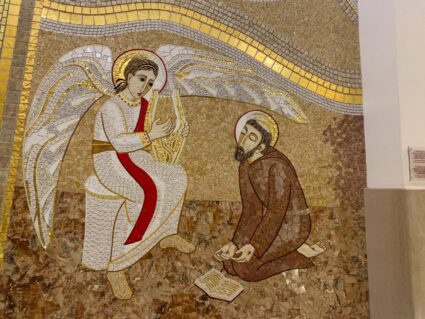
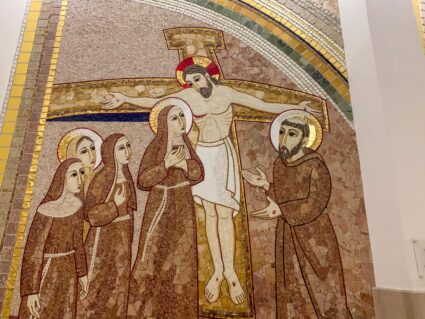
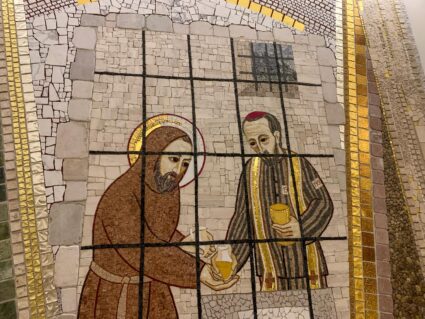
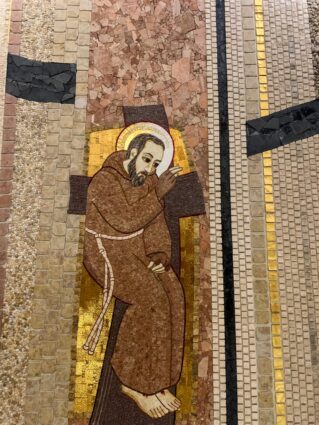
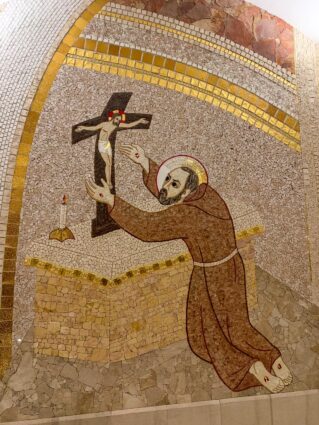
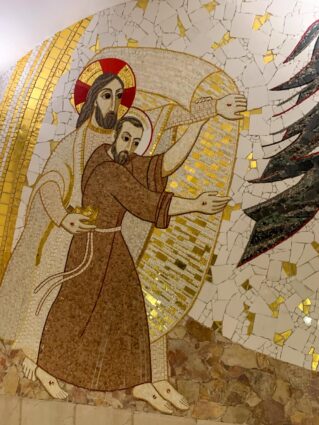
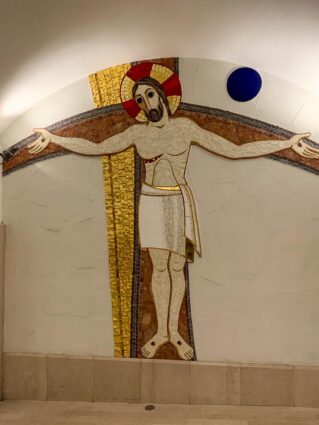
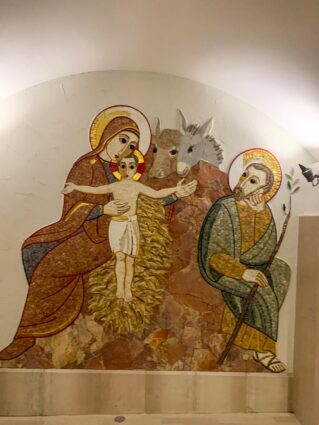
They were created by Father Marko Rupnik, a Jesuit who teaches at the Gregorian University, who considers Padre Pio’s shrine his masterpiece.
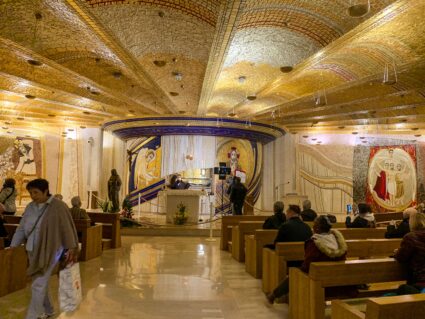
There are just an incredible amount of mosaics that he has designed to adorn the shrine. In fact, many years ago, we had a meeting of all the Capuchin bishops of the world and Father Rupnik came down from Rome and gave us an explanation of all the theology that is depicted in the mosaics. It was fabulous, just like a retreat.
On the way back to Rome, we stopped at the shrine of the Volto Santo (Holy Face) of Manoppello, which I had heard of but didn’t know much about. It is in the Basilica of the Holy Face that has been run by the Capuchins for 400 years.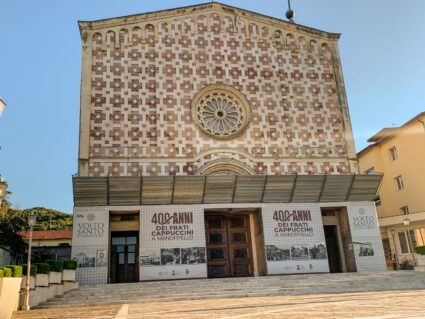
The Volto Santo is an image of Christ’s face on cloth. Some say it’s the actual Veil of Veronica. I’m not sure I can settle that question, but it was very interesting stop!
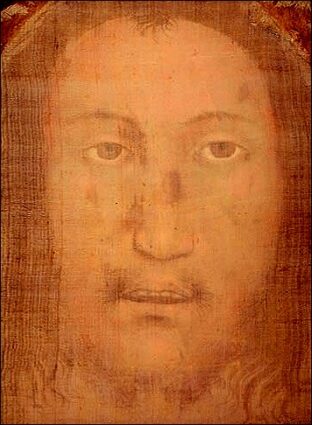
By Saturday, I was back in Boston and met with the Archbishop of Kingston, Jamaica, Kenneth Richards. He was here in Boston to celebrate the ordination anniversary of a friend and stopped in to see me.
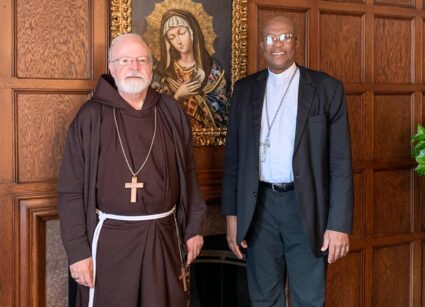
I had met him when I was visitator for the seminaries in Kingston. And, of course, when I was Bishop of the Virgin Islands I participated in the Antilles Bishops Conference and I had a lot of contacts with Jamaica. So, it was very good to see him.
Also that day, I was visited at the cathedral by Sean and Gina Kennedy and their son Declan. Sean was a lay missionary in the Virgin Islands when I was there and started our homeless shelter, Bethlehem House. I celebrated their marriage in the Virgin Islands and, later on, when they were in Rome, I baptized Declan in St. Peter’s Basilica. (You can read about that in one of my earliest blog posts. How time flies!)
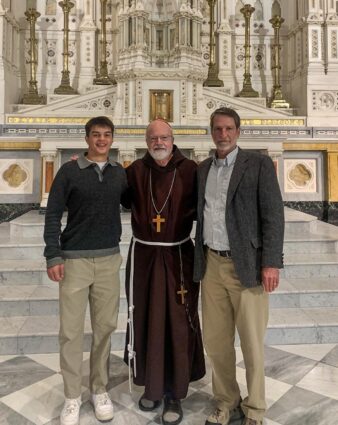
They were here for a meeting at MIT and stopped in to take a tour of the cathedral. Since there was no one else with us, we had to take two different photos to get everybody. (What God has joined together the camera will put asunder!)
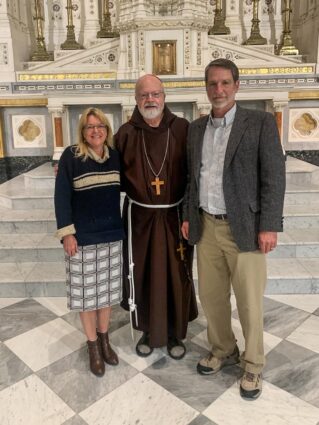
Sunday, I went to St. Agatha’s in Milton to celebrate a Mass to mark the parish’s centennial anniversary.
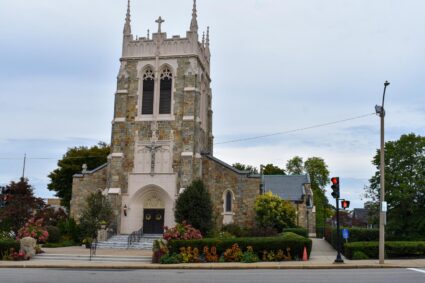 Concelebrating with me, along with the pastor, Father Bill Palardy, were a number of priests who were from the parish or had been stationed there, including former pastors Fathers Kevin Toomey and Peter Casey.
Concelebrating with me, along with the pastor, Father Bill Palardy, were a number of priests who were from the parish or had been stationed there, including former pastors Fathers Kevin Toomey and Peter Casey.
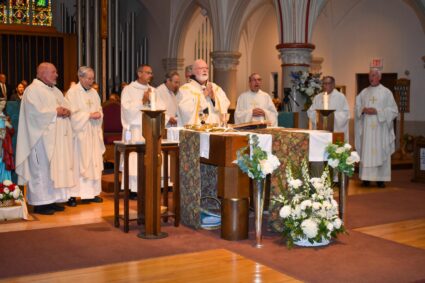
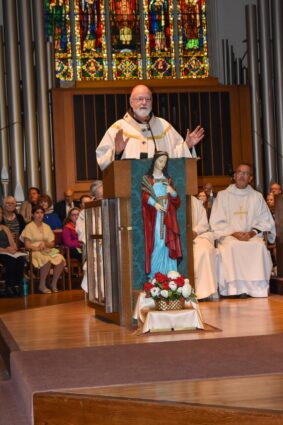
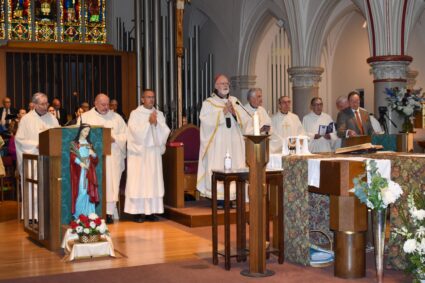
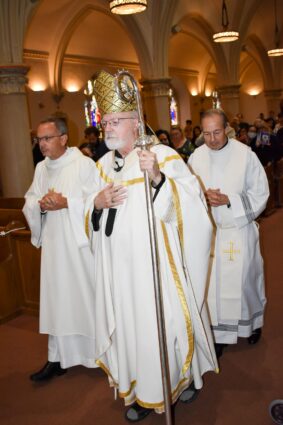
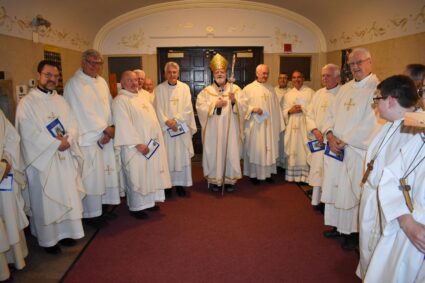
I was also very happy to see Mary Ryan, who just celebrated her 100th birthday. Mary and her husband were very involved in the leadership of the Order of the Holy Sepulchre, and her daughter Mary also serves on our Archdiocesan Finance Council. It was very good to see her and congratulate her.
Monday, I went to Washington, D.C. for a meeting of the Board of Trustees of the Catholic University of America. It was our first meeting with the new president, Peter Kilpatrick. It was very encouraging to see how well the new president has acclimatized to his job and there was a lot of enthusiasm from the Board of Trustees.
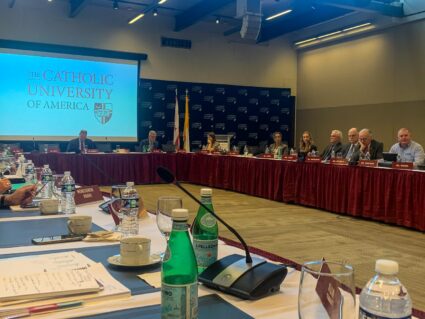
It was also the first meeting for Archbishop Borys Gudziak, the Ukrainian Catholic Archbishop of Philadelphia, who is new to the board. We are very pleased to have him with us.
Catholic University is the bishops’ university, a pontifical university and has trained much of the leadership of the Church in the United States. So, I am very happy to serve on the board and help the mission of this very important institution.
Wednesday, I went to Our Lady Help of Christians Church in Newton for the funeral Mass of Father Dan Magni. Father Dan had been a Xaverian Brother for 22 years and then went to Pope John XXIII Seminary and spent another 40 years of ministry as a priest of the Archdiocese of Boston.
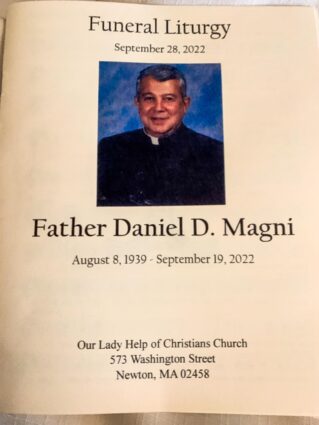
Father Al Capone gave a very beautiful reflection in his homily and many members of Father Dan’s large, Italian family were with us for the Mass. It was a lovely tribute to a man who gave so many years of service to the Church.
Later that day, we had a virtual meeting of the Archdiocesan School Council. I spoke a little about the importance of Catholic identity and then we had a time of conversation with the members. It was an interesting discussion, and we are very grateful for the service they provide and all their support of Catholic education.
That night, I went to Pope John XXIII National Seminary for their annual Lawn Party.
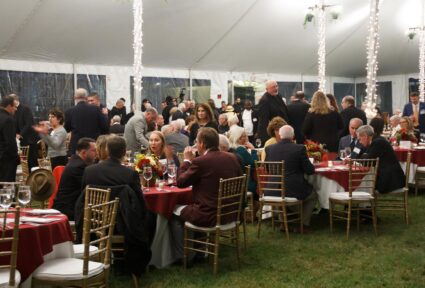
It was a very successful event with about 300 or so guests and alumni. We were also very happy to be joined by a number of bishops from the dioceses that send men to Pope John Seminary, as well as Abbot Vincent Rogers, the new abbot of St. Joseph’s Abbey in Spencer, who is himself a graduate of Pope John.
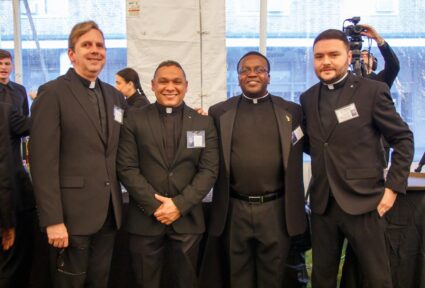
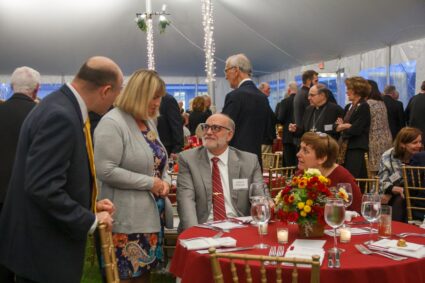
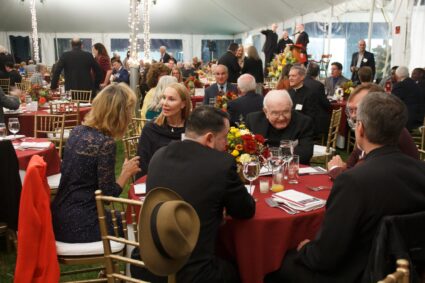
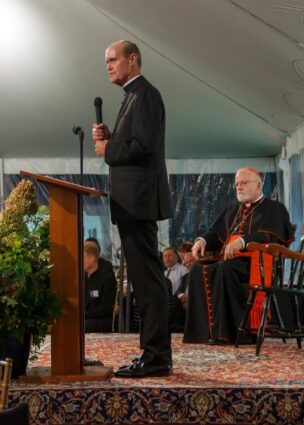
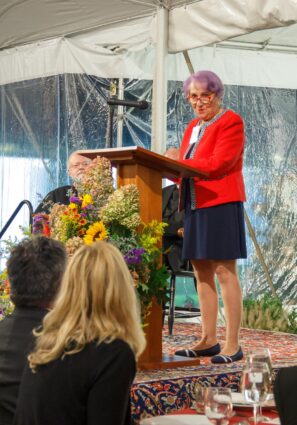
The seminarian speaker this year, Joe Gonzalez, is studying for the Archdiocese of Washington.
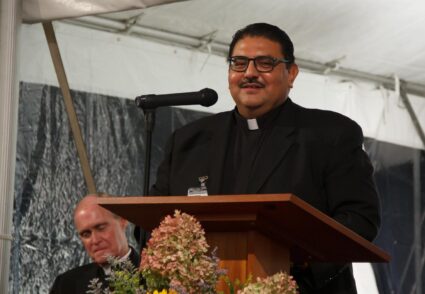
I was very touched by his talk because he spoke about his family coming from El Salvador when he was four years old and attending my Mass every Sunday at the Capilla Latina. He also talked about me baptizing all of his cousins and giving them First Communion and other sacraments. Later on, he joined the Marines, became a software engineer and eventually found his way into the seminary.
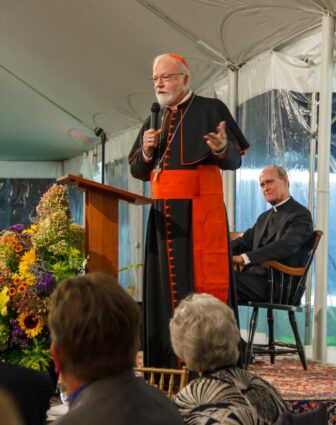
He gave a very beautiful witness talk and I was very honored to be a part of his vocation journey.
Thursday, we had a meeting of the board of St. John’s Seminary, where we were very happy to be joined for the first time by two new board members – Msgr. Marc Caron and Deacon Stephen Kaneb.
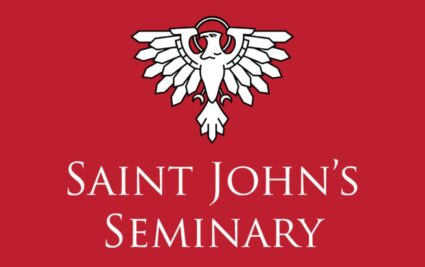
We spoke about what the seminary is doing to prepare for the propaedeutic year and other requirements related to the new regulations for priestly formation.
Finally, this week, the Holy See announced new members for the Pontifical Commission for the Protection of Minors: Bishop Peter Karam, Bishop Thibault Verny, Father Tim Brennan, MSC, Sister Mary Niluka Perera, RGS, Sister Annah Nyadombo, HLMC, Dr. Irma Patricia Espinosa Hernández, Ms. Maud de Boer-Buquicchio, Dr. Anne-Marie Emilie Rivet-Duval, Ms. Teresa Devlin, and Ewa Kusz.
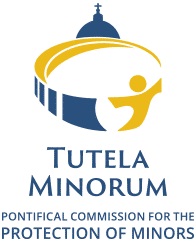
We are very grateful to the members who have finished their terms and who served with such distinction and generosity to promote safeguarding throughout the world. And we are also very grateful for the new members who are coming aboard. We have members from the Francophone world now, a member from Mexico, which is one of the largest Catholic countries of the world, and a Bishop from the Maronite Rite, who is our first Eastern Rite Catholic on the commission.
The Holy Father has given us new responsibilities now that we are part of the Dicastery for the Doctrine of the Faith. We are very grateful for the willingness of these new members to serve and grateful that the reach of the commission is being expanded.
I’d like to share with you an interview I gave to Vatican Radio regarding the new appointments and the work of the commission going forward:
Until next week,
Cardinal Seán
